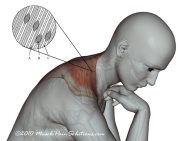Jaw Muscle Pain — What a headache!

Anyone who has suffered from jaw muscle pain can tell you that it can really get in the way of living your life! I have suffered from jaw problems with a periodic TMJ headache since middle school, but didn't really understand the severity of the problem until high school when my jaw got stuck open for 45 minutes. For the rest of the week, it would get temporarily stuck every time I yawned or tried to take a large bite. Since then, I have also struggled with clenching my jaw at night, and the pain that creates in the morning. Fortunately, I have found ways to decrease these problems, though not eliminate them. I would like to share what I have found.
The temporomadibular joint (TMJ) is a very complicated joint with a disc that rides up and down a ridge on the skull, in front of the ears. It has two joint capsules, many tiny ligaments and many muscles guiding the opening and closing of the jaw. It is hard to do much about the joint itself. Fortunately, much of the pain and even much of the dysfunction comes from the muscles influencing the joint, and some that just refer pain to the joint.
I have found a kit that includes a massage tool and video that teaches you specifically how to work these muscles in an easy to use and graphic way. If you suffer from frequent TMJ headache and jaw muscle pain, this would be the most effective and cost efficient way to deal with your problem. If your problem is not that severe, try working the muscles listed below with your fingers. This may do the trick for you.
How to Massage for Jaw Muscle Pain
Use this chart is a quick reminder for easy treatment of trigger points. For more complete info, check out the self massage page, or check out the page on trigger point treatment.
Self Massage: Trigger Point Pressure Release |
|
The following muscles are listed in the order of most likely to least likely to create jaw muscle pain. As the muscles inside the mouth are very sensitive, massaging them once per day, or even every other day is sufficient.
Lateral Pterygoid — This muscle is largely responsible for TMJ (temporomadibular joint) problems and pain, but it also refers pain over the cheek bones, and can imitate sinusitis. It can also create popping or clicking, and pull the jaw forward. In some people, this muscle can create tinnitus. The lateral pterygoid is irritated by clenching your jaw, chewing gum, ice, and nails. It can be strained by having your mouth open for a long time, such as with dental work, or mouth breathing. To massage this muscle, reach your index finger inside your mouth but outside your teeth as far back and high as it will reach. You will find a deep pocket there. Push upward and inward to work on the muscle. If you need it, this area can be excruciating. Work slowly and gently, but persistently to eliminate trigger points in this muscle. Click here for a picture.
Medial Pterygoid — This muscle is located inside the mouth, starting at the inside of the angle of the jaw and ending at the hard palate. You can massage it by pushing your thumb up against the underside of the angle of the jaw. You can also massage it by reaching your finger behind your back teeth and pushing into the soft tissue on the back/bottom of your mouth. Pressure there can cause a gag reflex, so breathe deeply as you reach in. Trigger points in this muscle make it hard to open your mouth very wide, and can create stuffiness and lack of draining of the middle ear. This muscle is strained by the same things as the lateral pterygoids. Click here for a picture.
Masseter — This muscle is the main chewing muscle, and starts right under your cheek bone, and ends covering the angle of your jaw. It is the one you will feel pop out right in front of your ear when you clench your jaw. It is irritated by clenching your jaw, chewing gum, ice, and nails, as well as dental work. In addition to creating jaw muscle pain, it also creates pain above the eyes, facial pain, tooth pain and sensitivity to heat and cold. It can also act like a sinus problem with sinus pain, drainage, and stuffiness. It can also create deep ear pain, itch, or even a low roar in the ears. To treat this muscle, put your thumb inside your mouth outside your teeth, and fingers outside, and pinch. If you need it, it will hurt like crazy, but be patient and persistent with this and you will get relief from your symptoms. Click here for a picture.
Sternocleidomastoid (SCM) — This is a very interesting muscle that can create a whole spectrum of problems, from jaw pain to dizziness and nausea, to ear ringing and headache. The muscle has two branches - the sternal branch that runs from the skull behind the ear to the breast bone, and the clavicular branch that runs from the same place behind the ear underneath the sternal division to the collar bone. The sternal division can create the pain on the cheek bones, and in the jaw muscles. The clavicular division can create the pain in the ear that can feel like jaw pain. The trigger points are located along the whole length of the muscle. For more complete info on this muscle, click here.
Trapezius — This large muscle, called trapezius for it's shape, is very complex and has a number of trigger points. Trigger point #1 is located right where the neck meets the shoulder, and can create referred jaw muscle pain. Pinch the small roll of skin right where the shoulder joins the neck. It feels like a tight band and sends pain to the temples, angle of the jaw, down the neck behind the ear, deep behind the eye, and to the back of the head. For a picture of this muscle, click here.




